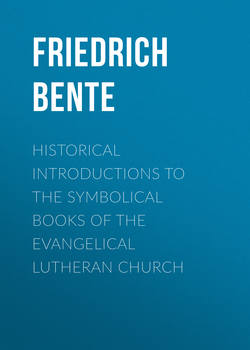Читать книгу Historical Introductions to the Symbolical Books of the Evangelical Lutheran Church - Bente Friedrich - Страница 15
II. The Three Ecumenical or Universal Symbols
15. Niceno-Constantinopolitan Creed
ОглавлениеIn order to suppress Arianism, which still continued to flourish, Emperor Theodosius convened the Second Ecumenical Council, in 381 at Constantinople. The bishops here assembled, 150 in number, resolved that the faith of the Nicene Fathers must ever remain firm and unchanged, and that its opponents, the Eunomians, Anomoeans, Arians, Eudoxians, Semi-Arians, Sabellians, Marcellians, Photinians, and Apollinarians, must be rejected. At this council also Macedonius was condemned, who taught that the Holy Spirit is not God: elege gar auto me einai theon, alla tes theontos tou patros allotrion. (Mansi, 3, 568. 566. 573. 577. 600.) By omissions, alterations, and additions (in particular concerning the Holy Spirit) this council gave to the Nicene Creed its present form. Hence it is also known as the Niceno-Constantinopolitan Creed. The Third Ecumenical Council, which assembled at Toledo, Spain, in 589, inserted the word "Filioque," an addition which the Greek Church has never sanctioned, and which later contributed towards bringing about the great Eastern Schism. A. Harnack considers the Constantinopolitanum (CPanum), the creed adopted at Constantinople, to be the baptismal confession of the Church of Jerusalem, which, he says, was revised between 362 and 373 and amplified by the Nicene formulas and a rule of faith concerning the Holy Ghost. (Herzog, R. E., 11, 19f.) Following is the text of the CPanum according to Mansi:
Pisteuomen eis hena theon patera, pantokratora, poieten ouranou kai ges, oratwn te pantwn kai aoratwn. Kai eis hena kurion Iesoun Christon ton huion tou theou ton monogene, ton ek tou patros gennethenta pro panton ton aionon, phos ek photos, theon alethinon ek theou alethinou, gennethevta, ou poiethenta, homoousion to patri, di' ou ta panta egeneto, ton di' hemas tous anthropous kai dia ten hemeteran soterian katelthovnta ek tov ouranon, kai sarkothenta ek pneumatos hagiou kai Marias tes parthenou, kai enanthropesanta, staurothenta te huper hemon epi Pontiou Pilatou, kai pathonta, kai taphenta, kai anastanta te trite hemera kata tas gpaphas, kai anelthonta eis tous ouranous, kai kathezomenon ek dexion tou patros, kai palin erchomenon meta doxes krinai zontas kai nekrous; ou tes basileias ouk estai telos. Kai eis pneuma to hagion, to kurion, to zoopoion, to ek tou patros ekporeuomenon, to sun patri kai huio sumproskunoumenon kai sundoxazovmenon, to lalesan dia ton propheton, eis mian hagian katholiken kai apostoliken ekklesian. Homologoumen hen baptisma eis aphesin hamartion; prosdokomen anastasin nekron, kai zwen tou mellontos aionos. Amen. (3, 565.)
